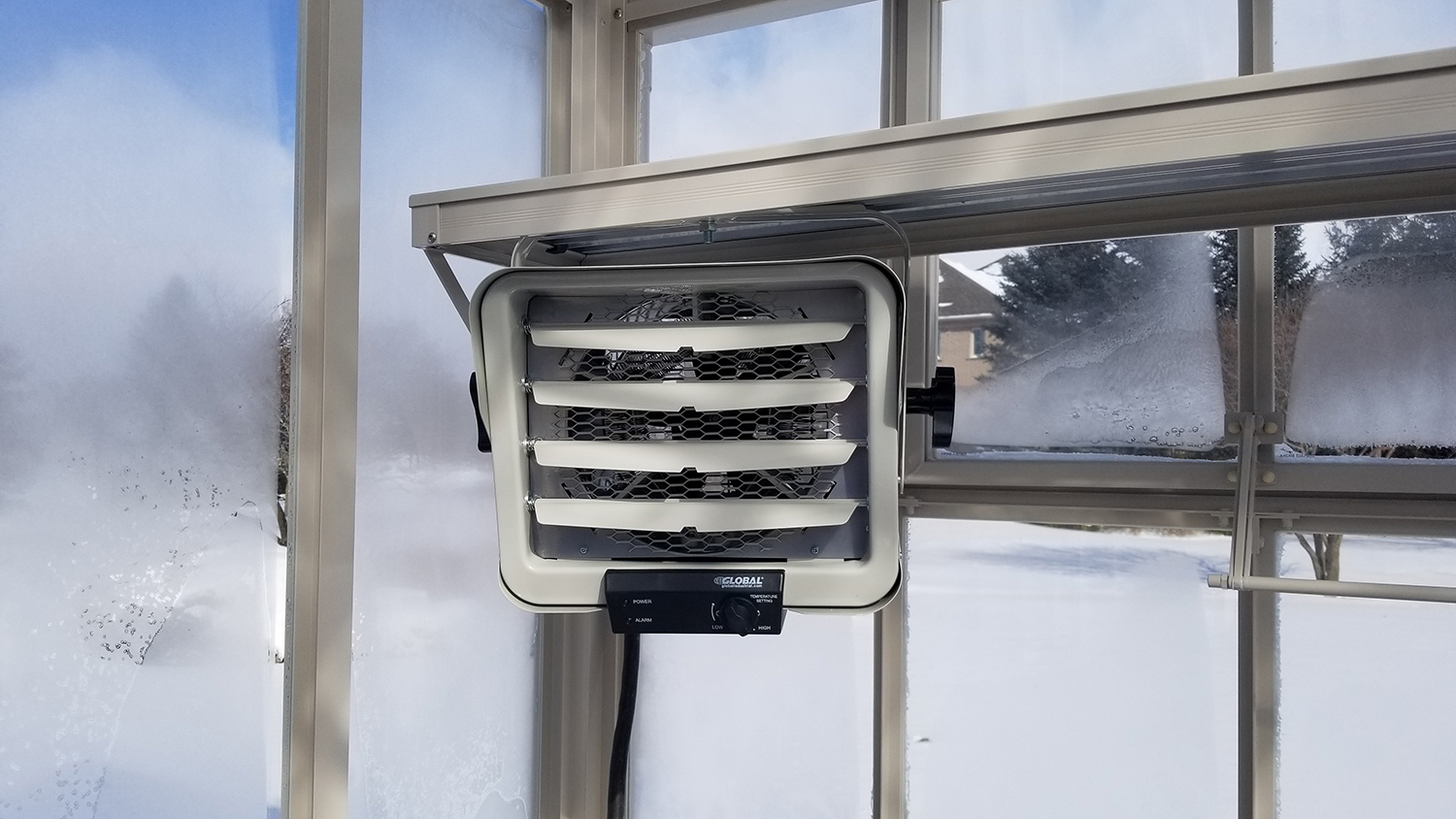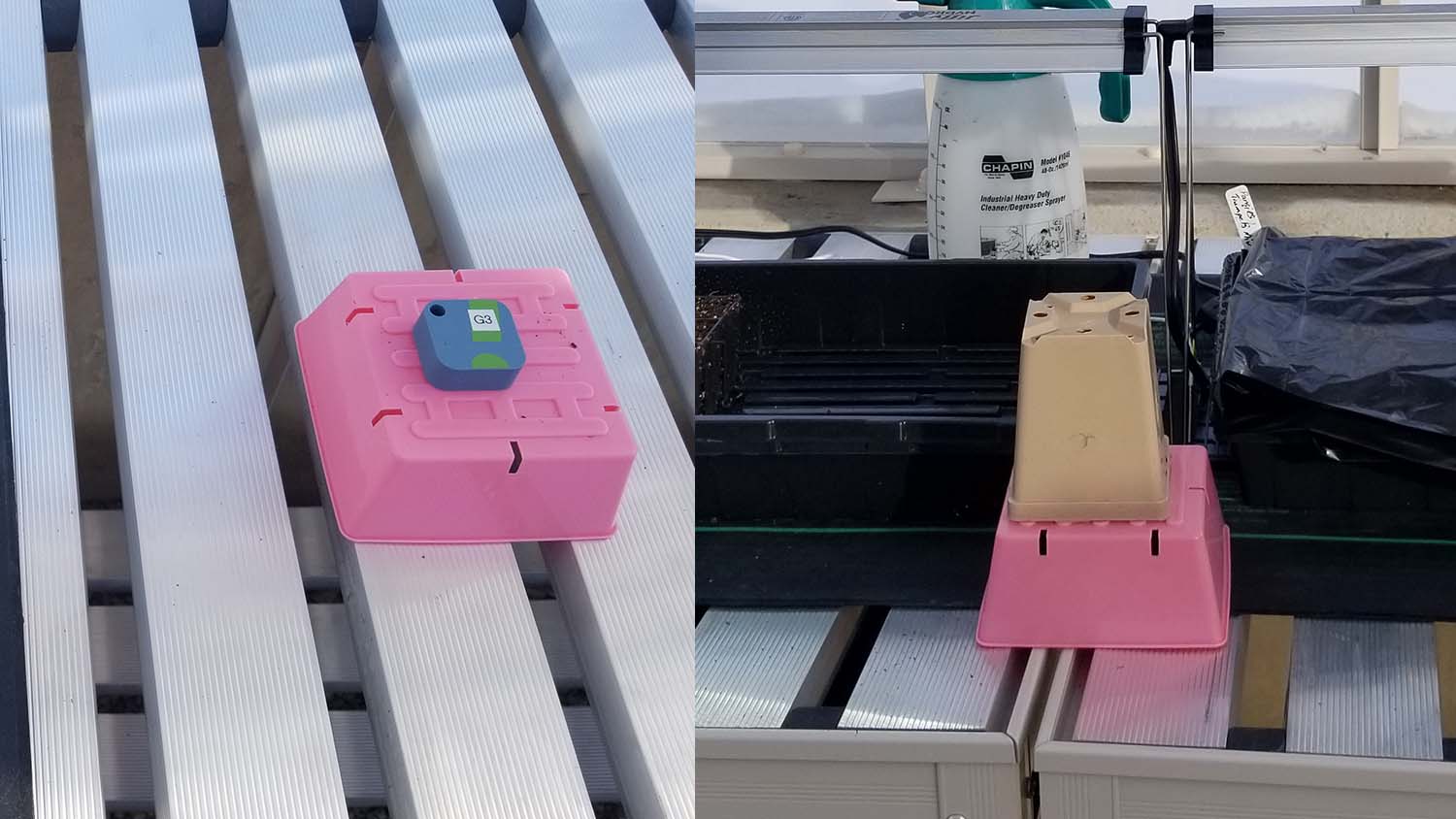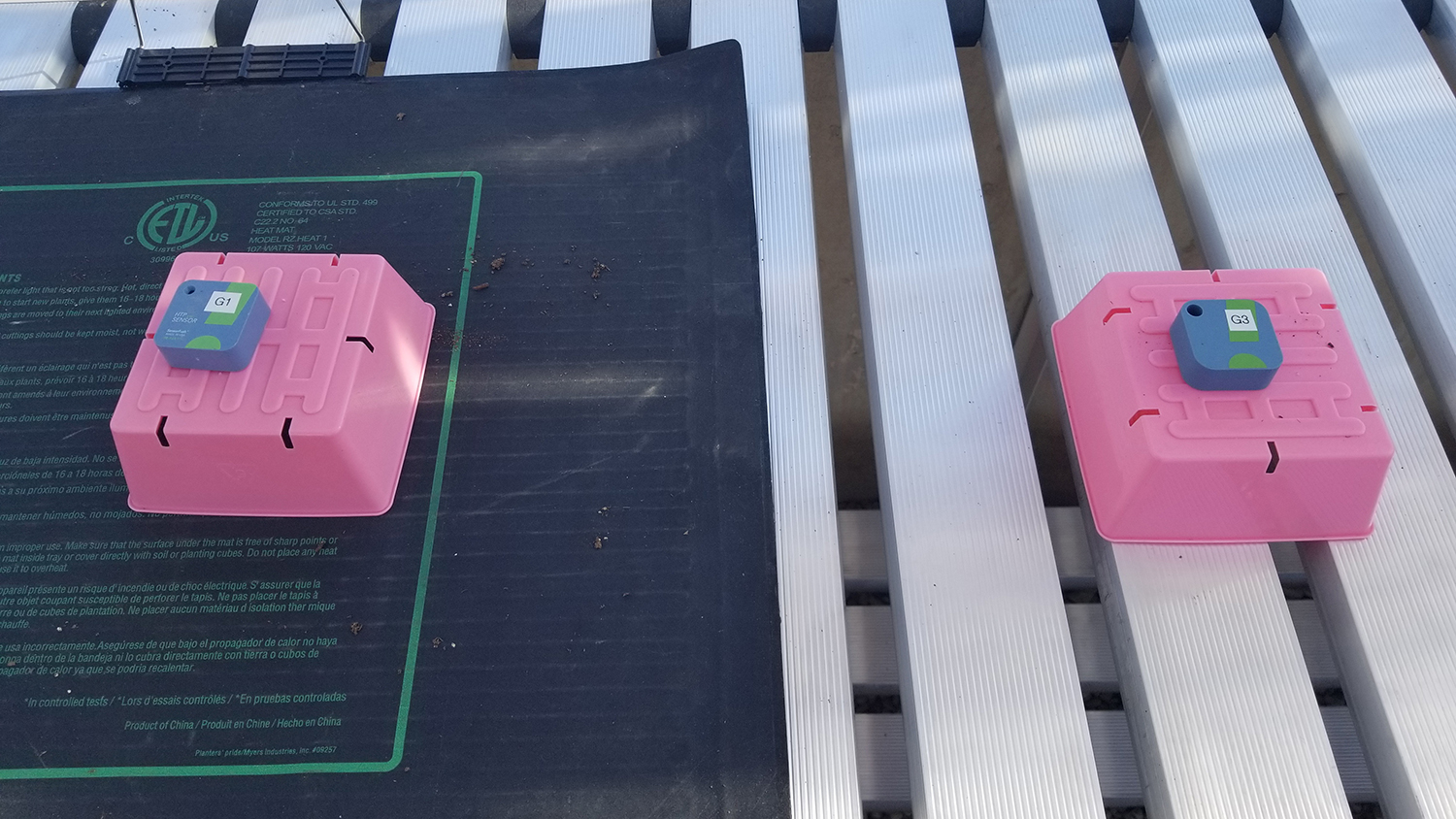
One of the heaters in the greenhouse
One of the decisions I had to make when building our Hartley greenhouse was how it would be heated.
Ultimately I decided to go with electric heaters. While not as efficient as gas, I was way more comfortable with the idea of having two electric fan heaters than I was installing gas heaters. The setup was easier, it didn’t require any venting and I have no worries about fumes. Yes, my hydro bill will be high and it will cost more than gas. So the trick will be to find ways to lower the heating costs as much as I can early in the season.
Most years I suspect I won’t turn the greenhouse on until mid-February. April and May won’t require a lot of supplemental heating but February and March will. So, I ran some experiments to see how low I could set the thermostats on my greenhouse heaters and what other ways I could heat sections of the greenhouse, rather than the entire area.
Heating and Monitoring Setup
The first step was to figure out how much heat I might need. The team at Hartley helped me with this advising that if I wanted to raise the temperature from -12 Celsius (10 Fahrenheit) to 7 Celsius (45 Fahrenheit) I would need an output of roughly 38,000 BTUs. Raising the BTUs to 45,000 would raise the temperature above 10C or 50F.
The average low in my area in March is around -4C or 24F. With that in mind, I decided to purchase two multi-watt heaters that would provide a maximum output of 17,060 each or 34,000 BTUs in total, a little less than the range suggested by Hartley.
Each of these heaters has a built-in thermostat control knob although it’s a simple low-high setting range. I thought I’d like a little more control than that, so I ordered separate temperature thermostats for each. My electrician rewired the heaters so that the unit itself is set to run on high, with on-off controlled by the temperature thermostats on the wall of the greenhouse. This works, sort of, as you will see from my experiments. I also have an oscillating fan in the greenhouse to help circulate heat evenly.
To monitor the temperature, my husband bought me two SensorPush temperature and humidity sensors, along with a gateway, for Christmas. This setup allows me to monitor my greenhouse temperature over my phone and it keeps its history. A couple of years ago I used an Engbird and didn’t find it worked consistently. I’m happy to say my experience with the SensorPush has been very good. I set the sensors on top of an upsidedown pot, covered by another pot, to accurately measure the ambient temperature less affected by direct sun or radiant heat (or cold) from the aluminum staging slats.

Setup of the SensorPush thermometers in the greenhouse.
Heat Experiments
While I’ll likely not leave the heat in the greenhouse on most winters, this being the first winter I of course decided to run the heaters in December and January and experiment. The winter of 2021-2022 proved to be a great one to see just what this heating setup could do since we had an extended period of unusually cold weather in January and February.
Here are the results of some of my heat experiments.
Experiment #1 – High Heat
For the first set of experiments, I set the thermostats to roughly 72F (yes my thermostat only shows Fahrenheit) or 22C. I wanted to see just how well these heaters could do.
The first night, the low outside was -2C. Inside the greenhouse at the growing level, the low was 12C. So the heaters could not keep the temperature at 22C but it was certainly warm to germinate and grow seedlings.
Other experiments were similar. A low of 2C outside resulted in a low inside of 14C.
A low outside of -6C resulted in a low inside of 10C.
On January 2, 2022, the low was a cool -13C and the heaters managed to maintain a temperature no lower than 7C, so still well above freezing.
What you’ll note in these results is that the amount I was able to raise the temperature varied. When it was very cold out (-13C) I could raise the temperature by 20C. Yet, when it was -2C I could only raise the temperature by 14C. That seemed odd to me. I think the reason has to do with conflicts between the wall thermostat and the on-unit thermostat. More on that at the end of the post.
Experiment #2 – Lower Heat
My next test was to see what would happen if I reduced the thermostat setting. So I lowered both to 60F or 15C. I still kept the oscillating fan running.
That first night the low was again -12C and the heaters maintained a temperature low of 5C.
So lowering the thermostat by 7 Celsius only resulted in a drop in the lows of around 2 Celsius. Interesting.
Experiment #3 – Using a Heat Mat
My third test was to see how much ambient heat could be generated near seedlings at night using a heat mat. I understand that a heat mat will raise the temperature of the soil for germination, but just how warm would the air above the heat mats be?
With the thermostat still set at 60F (15C) I put one thermometer on the top of an upside-down pot, on top of the heat mat and a second with the same setup 10 inches away from the heat mat. Both were then covered by another pot.

Sensor setup for heat mat experiment
That night the outside temperature low was -14C. What I found was that on the mat, the ambient air low was 9.3C, while off the mat the low was 5.2C. Using a heat mat increased the ambient air by between 4C and 5C most of the night. This is a good indication I can save on heating costs by lowering the temperature in the greenhouse and using heat mats. Not surprising but now I know how much the air temperature will increase above the mats with my setup.
Experiment #4 – Heat Mat Plus Humidity Dome
My final experiment was to add a humidity dome on top of the plants on the heat mat and see what the ambient air would be under the dome. The low that night outside only fell to -6C however by using a heat mat plus humidity dome I was able to raise the ambient air by between 9C to 10C.
I wanted to see if this temperature difference would hold if I lowered the heat in the greenhouse overnight. So I lowered the thermostats to the main heaters to 50F. That night the low outside was -18C, definitely cold. Off the mat, the low in the greenhouse was 4.5C. On the mat, under the dome, the temperature low was 14.6C. Still a difference of 10C! So I can keep the greenhouse just above freezing, but keep plants more than warm enough in a small section during the first start of the growing season. This will work perfectly since early starts are also cool-season crops.
Thermostat Conflicts
Throughout the season I’ve noticed an inconsistency of when my heaters turn on and off. Setting the thermostat at 60F does not seem to mean the heaters will run non-stop until the temperature rises above 60F. They still cycle on and off. The temperature can be 64F (18C) and they will be running. A while later the temperature can be 15C (59F) and they will not. Even during the cold of the night, the heaters will cycle off although the temperature is well below what the thermostats are set for.
I think was is happening is that the heat around the heaters gets warm enough to shut them off based on the on-heater thermostat. So, even though it’s set at high, the on-heater thermostat sometimes kicks the unit off. The solution would be two either buy two new heats without thermostats or have the electrician try to disable the thermostats on my current heaters. For now, I’m going to leave things as is. I know I can keep my plants from freezing, which is my goal. I’ll just have to monitor and adjust the wall thermostats seasonally.
Thanks for this! I am currently beginning an orchid obsession in the Seattle area where winters are quite stubbornly cold. I have a north facing solarium-type window that I am going to set up with grow lights but have been wondering about how to create a warmer ambient temperature (the humidity won’t be a problem of course lol) and this helped tremendously as I was hoping to avoid any type of heater and was very curious about heating mats! cheers!
Hi, just stumbled upon your site. Going to construct an 8×12 south facing lean to free standing greenhouse. Hoping to start heating end of March. Did you calculate heating costs for the various heating options you tried? If so, what was the most cost effective heating?
Thanks, Stu
Hi Stu. I am waiting until my February usage comes in so I can compare the two coldest months of greenhouse use between electric only (2023) and electric plus hydronic (2024). What I can tell you is in January 2023 our overall hydro usage increased by 2,711 Kwh. Most of that would have been due to the greenhouse. In December 2023 (when I was running both hydro + floor heat via gas) my hydro use dropped 2,457 kWh. December 2023 was unusually warm – roughly 5°C warmer than the year before, so that contributed to some of the reduction but with the radiant floor the hydro heaters had to run way less so the greenhouse is most of that decrease.
Gas is tricky because our meters are not read monthly. However, in December 2023 my average daily usage was 14.87 cubic meters per day. In 2022 (no gas for the greenhouse) it was 17.58 cubic meters per day – more because it was colder in 2022. However you can see my gas usage is hardly moving up, while my electric dropped by half when I put in hydronic heat.
Gas is way cheaper in Ontario Canada than electricity so it’s better to switch to gas.
I’ll have better numbers in a couple months and plan to put up a post about that so check back in if you like. At the end of the day, the hydronic system is saving a significant amount in terms of cost – hundreds per month. If you haven’t already, you can read my other posts about installing and then adjusting the hydronic / radiant system. You can also see how the hydronic floor held up to extreme cold.